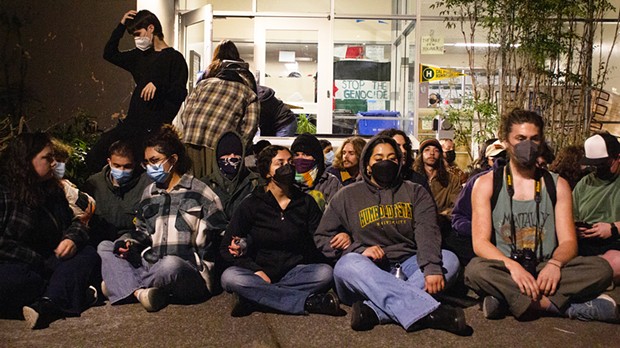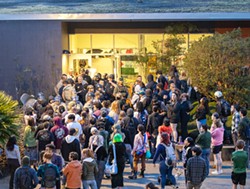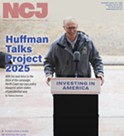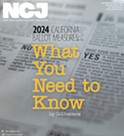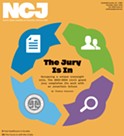[
{
"name": "Top Stories Video Pair",
"insertPoint": "7",
"component": "17087298",
"parentWrapperClass": "fdn-ads-inline-content-block",
"requiredCountToDisplay": "1"
}
]
The reverberations of the seizure of Cal Poly Humboldt's Siemens Hall in solidarity with Palestinians will ring out for years in our community. As we've navigated a "hard-closed" campus, potential criminal charges against students and community members, and a dispersed Cal Poly Humboldt graduation with President Jackson wholly absent, it is worth thinking carefully about the actions of April 22 through April 30. I believe the students achieved much more than they lost.
The goals of the protest were clear: Students and community activists wanted attention focused on Palestine and the Israeli war in Gaza that has killed tens of thousands of civilians. The students wanted meaningful change in their community (primarily disclosure of and divestment from industries enabling the violence in Gaza). And like most protests, the organizers wanted to move the injustice of the civilian deaths front-and-center in discussions at the university. They wanted faculty, administration and other students to demonstrate they cared.
You could certainly argue they got almost all they wanted. Moreover, the actions at this tiny, rural university have been a pivotal part of what is now a global eruption of campus activism in solidarity with Palestinians. The actions of the student organizers demonstrated savvy social movement organizing strategies that will have worldwide ramifications for years to come.
I am a professor at Cal Poly Humboldt. I teach social advocacy and community organizing. I've been a part of many of the progressive actions, protests and rallies in Humboldt County for the past 18 years. Although I care and was heartbroken about the violence in Gaza, it was not a primary emergency for me. As students marched through campus earlier this semester with drums and chanting for Palestine, I would come out of my office and clap from the sidelines and then return to my office chair to answer emails and grade papers.
The initial April 22 sit-in was reported to have been organic, with students planning to use their bodies to persuade decision-makers to care through civil disobedience. The location of Siemens Hall was not random: It is the building where the president and provost work. As has been noted in the North Coast Journal, the initial action was deeply informed by activist Jewish students' desire to bring the spirit of Passover and the commitment to non-violence. They were not planning to impede classes or prevent administrators from doing their work.
The escalating variable was the administration's decision to bring in police and try to remove peaceful students. And not just the handful of university police, but to ask for assistance from seemingly every officer in a 40-mile range. That resulted in the students barricading the doors to Siemens Hall and a well-documented clash with charging police at one entrance in which they repelled the officers, resisting extraction while a crowd of supporters grew outside.
When I arrived at 9 p.m., there were easily 400 people passionately arguing that the police should leave and shouting pro-Palestinian chants around a ring of officers posted at every entrance of Siemens Hall. Inside, student organizers blocked the doors. The stand-off ended at 11 p.m. when the police simply left without explanation.
I would mark this as the first significant success of the demonstration. To face down a charge by armed police is no small feat. The scene probably sparked heated behind-the-scenes conversations between campus decision-makers about the optics, public relations and legal ramifications of removing protesters by force or retreating from the law enforcement strategy.
After this first night, the community of supporters and collaborators bloomed. Despite the warning to students, staff and faculty that they should avoid that area of campus and the subsequent closing of campus, hundreds of people came to see what was going on and be part of the moment. There was a palpable change in the space.
For the last three years, I have had many conversations about the post-COVID culture change on campus. As we would walk to the depot to get food, faculty and administrators who have been here for years would talk about how sad it was to see the quad usually empty, noting the electric student energy seemed absent.
The community created during the seven days of occupation should be counted as the protest's second success. I went up to check on the protest at 11 p.m. on Tuesday and assumed I would find the area desolate. It was the opposite — it was the most beautiful I've ever seen the Cal Poly Humboldt quad.
A Mutual Aid Kitchen and first aid station had been raised. There were at least four food stations with people grilling, making sandwiches and sharing tea. Students were resting on the lawn in sleeping bags. Punk and heavy metal bands played, with people dancing in enthusiastic circles. I joined a lively debate about protest tactics, and chatted with an Arcata High School student who was there just to see what was going on. The whole place was covered with chalk art and a blooming number of signs and posters marking political ideologies ("Jews for peace," "land back," "it's OK to punch Nazis"), demonstrating that the area around Siemens Hall was a new kind of community space.
The boundaries of the temporary autonomous zone grew over the next few days. Barricades of dumpsters and benches were moved to block off a circle of campus filled with art and people. Organizers and sustainers camped on all four sides of Siemens Hall. The activists took care of each other, defined the space as generous, compassionate and welcoming, and kept Palestine at the center of their political advocacy and organizing.
The third success came in the rapid amount of learning that took place solely because of the occupation. On Wednesday, April 24, the California Faculty Association, frustrated at the closure of campus and in an effort to reduce the tension, hosted a teach-in on the quad. Faculty, including myself, gave mini-lectures to hundreds of students there on non-violence, Palestine, incarceration, organizing and justice.
Isn't this the idealized vision of a university? Hundreds of engaged teachers and students who are curious about a subject learning and talking with each other. The student organizers were certainly learning at a lightning pace — connecting with other Palestine demonstrations erupting on campuses across the nation. The students and an increasing number of community members were educating themselves about Gaza, listening to student media (shoutout to The Lumberjack, KRFH-FM and El Leñador Cal Poly Humboldt student journalists). You couldn't go anywhere in Humboldt County without the occupation being discussed.
Community members, faculty and staff who hadn't been part of Gaza solidarity protests found themselves deeply involved. The students put themselves at risk and asked to be heard. Based on my visits to the occupation, they were largely successful. I met many older folks, alumni and campus staff who wanted to come see for themselves what was going on. Some disagreed, some wanted to debate and some just wanted to be present. I had a dozen world-class conversations on the quad during the seven days of occupation, the kinds you rarely found prior to the occupation, with staff, community, professors, activists and elders all talking about the bio-region, the legacy of protest at Humboldt, the impact of COVID on learning, risk-taking, Palestine, religion, civil disobedience and much more.
A lot of community members don't come to campus often, perhaps other than to see a concert. The town-gown division is as wide as I've ever seen. The protests operated as a kind of invitation for many to come to campus despite warnings it was closed. If the university administration had leaned into these protests, it is possible this could have been a signature success for the campus.
Cal Poly Humboldt's press releases seem to repeat the claim that: "over half of those arrested were not students," paralleling the Nixon-era "outside agitator" trope. It is worth rebutting these claims. Most of the non-students who were arrested were neighbors, friends, alumni and community members. A few came from out of the area inspired by the (now global) movement of campus communities escalating pressure to protest civilian deaths in Gaza. In the past, Humboldt would have been proud to be a beacon for justice and it is a disappointing turn that a student protest that was visible around the world is seen as a source of embarrassment by the administration.
The protest's fourth success was transparency and agenda setting to move Palestine to the forefront at the university. The faculty almost unanimously approved a vote of no-confidence in President Jackson and Chief of Staff Mark Johnson after the order of the first police attacks was given and the campus was closed. Since the vote of no-confidence, the University Senate has passed resolutions about Gaza and civilian deaths, the university has had at least one reasonably transparent discussion about Cal Poly Humboldt's investment strategies and higher-level discussions continue.
The fifth indication of protest's success can be measured by the grotesque overreactions from the administration and law enforcement. The campus was closed and classes were forcibly transformed into online sections no matter the subject (lab sciences? ceramics? face-to-face performance classes?). More than 75 students received bizarre interim suspensions, many based on no evidence other than apparently having used their phones on the campus WiFi network near the protests. The campus was "hard-closed" and faculty, staff and students were threatened with arrest if they stepped foot on campus. The administration's leaders called in more than 100 law enforcement officers from as far away as San Francisco for the final April 30, 2:30 a.m., police strike that arrested the 32 students and community members (including a professor of education). The drama was elevated to a peak that night with police cars driving around campus playing a looped recording that threatened the use of chemical agents and "non-lethal" bullets if people didn't disperse and the constant cadres of police marching through campus.
When they finally busted up the protest and arrested some demonstrators it was anticlimactic. Amped-up police arrived to find outraged community members and students who shouted, "Cops off our campus," from the legal speech side of the barricaded road. Inside the protest area, heavily armed riot cops dragged away 32 campus and community organizers who exhibited non-violent passive resistance. There was a judo-like inversion of power as the students met overwhelming military force with song, passive resistance and by simply holding hands. Never have so many people with so many guns seemed so powerless in Humboldt.
The cops who had been shamed in their first conflict with the protesters and will be forever mocked with memes about water jugs found they weren't the redemption force but largely viewed as an invading army that almost no student, faculty or community member thought necessary. If there were "outside agitators," they surely were the imported police.
We will see the full flowering of the sixth success of this protest once campus is back open. On that day, I suspect, we will see a massive Palestinian solidarity demonstration in the quad. Despite all the arrests, the show of force and the threats to anyone who steps on campus, I think more people will come to the next Palestine solidarity event at Cal Poly Humboldt than ever went to one before the campus was "hard closed."
There certainly were costs and harm associated with the protest and we will need accountability. Chief among these costs was the tragic decision to close campus, to threaten faculty, staff and students with arrest, and to make the last three weeks of learning at the university untenable. Opinions will vary, but I hold the administrators fully responsible for the choice to lock campus and prevent students from going to classes. We have had many other occupations and large protests where more generous and thoughtful prior administrations have engaged with the students while classes continued. In the spectrum of possible responses, this administration chose the far extreme when many other options were available.
I will also note that negotiations for the peaceful end of the demonstration were in progress throughout the entire occupation. Students, faculty and administrators were talking to each other about a variety of options to bring a peaceful conclusion. On April 27, demonstrators offered a straightforward deal of a trio of requests in exchange for leaving Siemens Hall. The offer was simply ignored.
Arrests and suspensions have consequences. Students and community members will have records (unless the district attorney chooses not to charge them), the community had to rally to find bail money for people who were locked up. The cost of lawyers and the hassle of dealing with court systems will pose hardships for the individuals arrested.
Punishments are rarely about the individuals selected — they are usually collective threats that if you do these things, these are the demonstrated impacts. For each student who got a terrifying interim suspension letter, the message was also communicated to dozens of their friends about their experience at Cal Poly Humboldt. Each student who was scared to leave their dorm room because there were armed police around them is connected to a family who had to drop what they were doing to drive to campus and load their child's half-packed belongings into an SUV.
The impacts of the administration's choices will be felt for decades in this community and beyond. The recruiting, retention and student success consequences will be shouldered by the caring and thoughtful people who do that work at this rural university. Cal Poly Humboldt, already struggling with enrollment and to retain vulnerable students, will find those tasks more difficult after this chapter.
Many have pointed to the negative impact on students who weren't involved in the protests. I agree. During the first days of the demonstration, some students I talked with didn't like the protest and were annoyed, inconvenienced and chose to mock the student occupiers. But after the administration chose to lock down campus, students who opposed the protest seemed to grow more sympathetic. Sending in legions of police certainly seemed to increase the sympathy for the demonstration, in many cases creating activists who didn't care about Palestine but were enraged at the heavy-handed police presence on campus.
Given the choice of avoiding some chanting protesters near the quad or having their semester ended, I think almost every student would have chosen to let the protests unfold and continue going to classes. Given that campus remained "hard closed" two weeks after the occupation was cleared, it is evident that it wasn't protestors who closed campus, but Jackson and Johnson. If the organizers had acceded to administration demands and peacefully walked away, the administration still wouldn't have opened campus because it wasn't about the demonstration — it was about shame.
It wasn't the protests that seemed to goad the administration, but the temerity of anyone to question their authority. The use of police to forcefully resolve the issue (twice) only underscored the faulty logic of an administration that committed to a singular way of thinking about the activated students on this campus. For those of us who grieve the loss of a traditional graduation ceremony to honor the incredible work of our students and their families, the following argument must be underscored.
The protest is over, police have arrested everyone and cleared the demonstration. Siemens Hall is empty. But for some reason the campus remains locked and our graduation ceremonies were spread to Blue Lake and Eureka with tiny major-based celebrations. The administration didn't care about the students graduating or getting an education. They have kept the campus locked because President Jackson didn't want to be booed in a football stadium.
There is a lesson here for other campus leaders — one that is being taken up at Brown and Sacramento State where administrators have allowed the Palestinian solidarity protests and encampments to be part of campus life rather than viewing them as an intrusion. Students at those schools get to have their labs and their graduation.
Naming the labor costs of the campus staff who are tasked with clean-up of Siemens Hall and the surrounding area is vital. There will be extra hours, work and resources spent to clean up after the protest. Human beings will have to paint over graffiti and move chairs back into buildings. Just as I don't take lightly the loss to families who don't get a full graduation, I also sincerely care about the work behind the scenes to clean all this up.
It is worth thinking about the cost of the cleanup in the context of where the mess came from. Most of the graffiti I saw on the campus was harmless, made in chalk. The graffiti written on the walls and the president's office were almost all expressions of political communication — efforts to mark the time and space with more permanent messaging. Although there are facilities management staff dutifully painting over the graffiti, I think photographs of those painted messages will be shown in Cal Poly Humboldt classes talking about protest next semester and into the future.
Some have claimed other costs that I think can be dismissed. The argument that the protesters broke into offices and had access to private employment files was repudiated. On Friday, April 26, the organizers took to the quad and opened the doors to Siemens Hall, inviting all to enter and take a look. Hundreds of community members, faculty and students walked through Siemens and saw the carefully organized first aid kits and peanut butter, as well as the locked doors that had been marked by organizers as off-limits and respected by their colleagues.
The exception was President Jackson's office, which had been cracked open and where people had written on the walls. These messages were almost all pleas for Jackson — a president notoriously disconnected from campus — to listen and engage. One reads: "I hope you sit in this uncomfort and find some empathy 2 create change use your power to help."
I know that the graffiti in the president's office has become one of the primary arguments that the activists crossed the line. This is certainly vandalism, but we could also think of these as expressions, communications of meaning that have some reasoning. I don't think the students and organizers were trolling. They weren't trying to enrage and infuriate. They were writing out of frustration, fear and anxiety. The messages are markers of undergraduates who felt betrayed and criminalized by their administration. Frankly, I was surprised the graffiti had so few personal insults and generally stuck to the messages of the protest.
The other critical argument was that Jewish people felt threatened by the protests. People interested in unpacking the history of the Israeli/Palestinian conflict should enroll in a political science, religion, history or critical race gender and sexuality studies (CRGS) class next fall. What we do know was that the demonstration was driven by many Jewish students who organized the protest to coincide with Passover, intending a multi-faith demonstration of solidarity with the civilians in Gaza. We also know that the activists hosted a shabbat dinner led by a local Rabbi during the occupation and, on Monday night before the police broke into the encampment and arrested everyone, the organizers had invited the community to a Seder.
I don't doubt that some Jewish people, forever scarred by the memory of the Holocaust, see these protests as anti-Jewish. But the more complex story is that many of the participants are Jews who believe that the actions of Israel against civilians are unacceptable. Most importantly, these protesters in Siemens Hall worked to try to invite Jewish people into the space to celebrate their own Jewish heritage without shame or fear. At every moment when these organizers could have been pigeon-holed as being antisemitic or having broken into offices, they demonstrated their sincerity.
The final (seventh) success of the Siemens Hall occupation is that the next generation has proven itself ready to lead. For years I have heard the disrespect of the Tik-Tok, COVID-damaged, solipsistic generation that are now college students. While they were being mocked, these students found themselves. For many 18 to 21 year olds, the civilian deaths in Gaza have been heartbreaking examples of the injustice of the world. They were radicalized and then honed their political analysis as their pleas for justice were ignored in their communities.
Here in their community, Cal Poly Humboldt, they chose to do something. They took risks, learned from their mistakes and pushed the community to be better. I'm proud of the fact that, by and large, the community responded. Hundreds of faculty were radicalized, hundreds of community members got connected to the students and the campus. And here in this place in the redwoods, these organizers demonstrated that people care about the death and destruction in Gaza and that so-called normal operations would not be allowed to continue.
Dr. Maxwell Schnurer is chair of the Communication Department at Cal Poly Humboldt.
Comments
Showing 1-1 of 1
Latest in Views
Readers also liked…
-
Hope
- Sep 7, 2023
-
California Says No to Privatizing Medicare
- Sep 21, 2023
